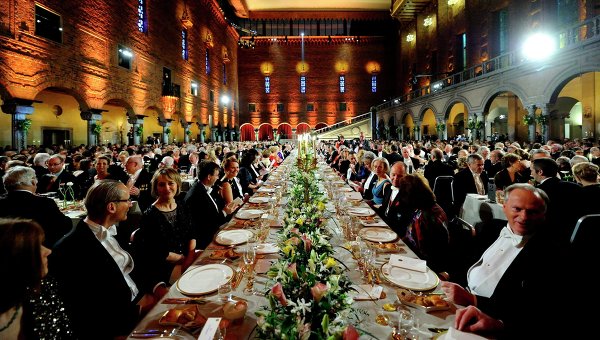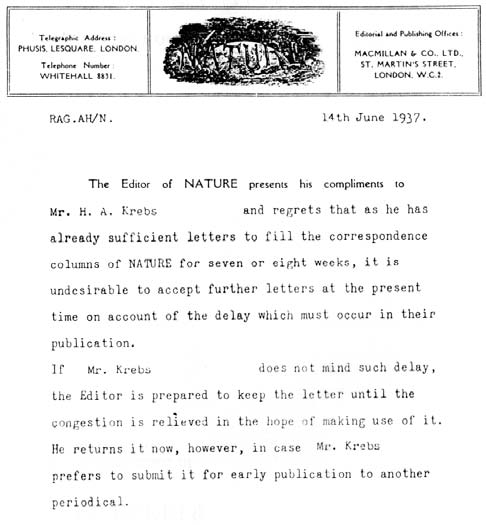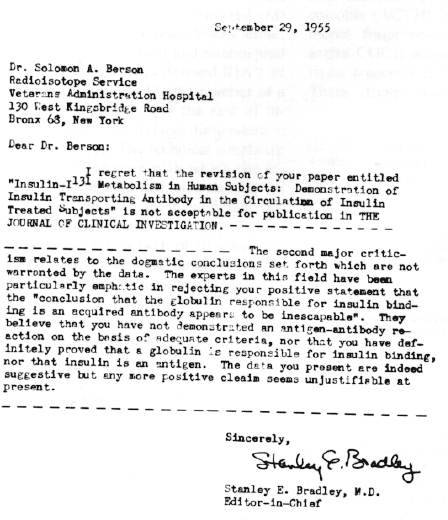8 scientific papers rejected and then won the Nobel Prize

Banquet in honor of the Nobel Prize winners in Stockholm
Not much can drop the spirit of a scientist as much as the rejection of your chosen work in a scientific journal that you have spent months or years on - especially when it seems to you that your topic is important.
It turns out that many world-famous researchers experienced a rejection of their work before, finally, their work was published, and in the future received the Nobel Prize.
')
And it cannot be said that the researchers were let down by the system of checking the publications because the process of rejection of works is part of the normal peer review process.
The expert assessment includes the verification of the article by independent researchers who read all the works submitted to the journal in order to make sure that the methods and conclusions described in it are weighty enough. Often, they propose to make changes, and may reject the work if it seems to them that something else needs to be done, or that it is simply not suitable for the magazine.
The final product, modified after the failure, usually turns out to be better than its first option - or, at least, gets into a more appropriate journal.
When you learn that even well-known works have experienced difficulties before a revolution in their field, you will understand that refusal does not necessarily mean the end of your research - sometimes this is just the beginning.
1. The fruitful work of Enrico Fermi on the weak interaction, 1933
“It contained theories too far from reality to interest the reader”
- Frank Close, " Small Things and Nothing ".
Weak interaction, one of the four (and possibly five ) fundamental interactions in nature, was first described by Enrico Fermi in 1933 in his Attempt to Formulate the Theory of Beta Radiation, published in the German journal Zeitschrift für Physik.
But before that, it was refused to be published in Nature magazine, since it was “too far from reality.”
The work served as the basis for the works that led to the Fermi Nobel Prize in physics in 1938 at the age of 37, for "proving the existence of new radioactive elements obtained by irradiation with neutrons, and the associated discovery of nuclear reactions caused by slow neutrons."
2. The work of Hans Adolf Krebs on the tricarboxylic acid cycle, known as the Krebs cycle , 1937

Yes, even those scientists whose names describe the processes described in textbooks, met with failures. There were no problems with Krebs' work, but Nature was so overwhelmed with the incoming articles that they simply could not read it.
“For the first time in my career, after I published more than 50 papers, I was rejected, or something like a half rejection,” Krebs wrote in his memoirs .
The work "on the role of tricarboxylic acids in intermediate metabolism in animal tissues" as a result was published in the Dutch journal Enzymologia a little later that year, and in 1953 Krebs was awarded the Nobel Prize in Medicine "for the discovery of the tricarboxylic acid cycle".
3. Murray Gell-Man’s work on the classification of elementary particles, 1953
“The title was not mine. I had: 'Isotopic spin and unusual particles'. Physical Review magazine rejected 'odd particles'. I tried 'strange particles', they and they rejected them. They insisted on the title 'new unstable particles'. Only such a phrase turned out to be pompous enough for the editors of the Physical Review.
I must say that I always hated the Physical Review Letters, and almost 20 years ago I decided never to publish it again in this journal, but in 1953 I was hardly in a position to choose. ”
- Murray Gell-Mans, " Strangeness "
Sometimes the journal does not reject the content of the article, but the title. As a result, the title did not matter, since Gell-Man awarded the 1969 Nobel Prize in Physics "for his discoveries related to the classification of elementary particles and their interactions."
4. The invention of radioimmunoassay , 1955

Many years after receiving the Nobel Prize in Physiology and Medicine in 1977 "for the development of radioimmunological methods for the determination of peptide hormones," Rosalyn Sasmen Yalow proudly demonstrated this letter of refusal.
He was sent from The Journal of Clinical Investigation, because experts were skeptical that a person could produce antibodies that were small enough to bind substances like insulin.
She proved them wrong, and now radioimmune analysis is a common way to determine antibody levels in the body. It works with an antigen labeled with a radioisotope, which is then tracked in the body.
5. The first model of the Higgs, 1964
"Peter Higgs wrote a second small work describing what was later called the 'Higgs model', and sent it to Physics Letters, but it was rejected due to the lack of reasons for publication."
- University of Edinburgh
This work took a long time to gain recognition, but after being rejected on the Higgs model in 1966, Higgs did receive his Nobel Prize in Physics in 2013, after discovering evidence of the existence of the Higgs boson at CERN experiments on ATLAS and CMS.
The original article, “Spontaneous Symmetry Breaking in the Absence of Massless Bosons,” was published in the Physical Review later that year.
6. Work on nuclear magnetic resonance spectroscopy (NMR), 1966
“However, the reaction to our invention was sluggish. The work that described our achievements was twice rejected in the Journal of Chemical Physics, and finally accepted and published in the Review of Scientific Instruments. ”
- Richard Ernst, " Nobel Prize "
You might not have heard about NMR spectroscopy , but it allows you to recognize the details of the structure and dynamics of molecules - and this is very convenient for chemists and biochemists.
But the first work with the application of Fourier transform to NMR, “Application of Fourier transform spectroscopy to magnetic resonance,” few people paid attention.
Richard Ernst received the Nobel Prize in Chemistry in 1991.
7. The discovery of quasicrystals, 1984
"She was rejected for the reason that she would not be interested in physicists."
- Dan Shechtman
Quasicrystals are ordered but not periodic structures. When Dan Shechtman first described these strange structures in 1984 in his work “The Microstructure of Quickly Cooled Al 6 Mn”, it was rejected in the Physical Review Letters, as relating mostly to metallurgy.
It was published later that year in the journal Metallurgical and Materials Transactions A, Shechtman continued to work on this topic, which led to his receiving the Nobel Prize in 2011.
8. The first work on the polymerase chain reaction (PCR), 1993
“Dan Koshland was the editor of Science magazine when my first work on PCR was rejected in this magazine, and he was also the editor when three years later the title PCR was given the title“ Molecule of the Year ”.
- Carey Mullis
Together with Michael Smith, Carey Mullis received the Nobel Prize in Chemistry in 1993 for “inventing the polymerase chain reaction (PCR) method”.
This technique is used daily in all laboratories in the world for the propagation of DNA chains. But the first job with a description of the technology was rejected in the journal Science. The reasons are not known to us, but I’m ready to bet that the magazine later regretted it bitterly.
To get an even greater idea of how many failures and failures are hidden behind success, check out the “summary of failures” published on the Internet by one of the professors of Princeton.
I do not know about you, but I felt much better.
Source: https://habr.com/ru/post/397087/
All Articles